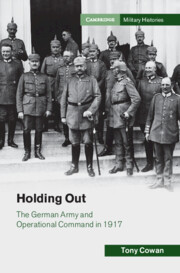Book contents
- Holding Out
- Cambridge Military Histories
- Holding Out
- Copyright page
- Dedication
- Contents
- Figures
- Maps
- Tables
- Acknowledgements
- Comparative Ranks
- Chronology
- Abbreviations
- General key to maps
- Introduction
- 1 Context
- 2 Principles
- 3 Organisation
- 4 Personality
- 5 Intelligence
- 6 Communication
- 7 Learning
- 8 Performance
- Conclusion
- Bibliography
- Index
- Holding Out
- Cambridge Military Histories
- Holding Out
- Copyright page
- Dedication
- Contents
- Figures
- Maps
- Tables
- Acknowledgements
- Comparative Ranks
- Chronology
- Abbreviations
- General key to maps
- Introduction
- 1 Context
- 2 Principles
- 3 Organisation
- 4 Personality
- 5 Intelligence
- 6 Communication
- 7 Learning
- 8 Performance
- Conclusion
- Bibliography
- Index
Summary
The German army recognised before 1914 the importance of communication to the third command task, reducing uncertainty, and evolved organisational, personal and technical means to handle it. Realities of battle in 1917 confirmed some pre-war ideas and disproved others. Headquarters expanded and were forced to the rear by firepower. Bureaucratic burden continually increased despite attempts to reverse it and partly because of failure to adopt modern methods of information handling. Personal contact remained essential to command, though 1917 conditions made it more difficult. The same conditions led to ever-greater reliance on technical communications means and organisations, which were continually developed. Performance of the communications system in the spring fighting was at least adequate, including because of the attackers’ slow tempo. Subsequent developments of doctrine and organisation. Unstoppable growth of bureaucracy and linked problem of falsified reporting were danger signals that the urge to reduce uncertainty had got out of hand.
Keywords
- Type
- Chapter
- Information
- Holding OutThe German Army and Operational Command in 1917, pp. 190 - 214Publisher: Cambridge University PressPrint publication year: 2023

